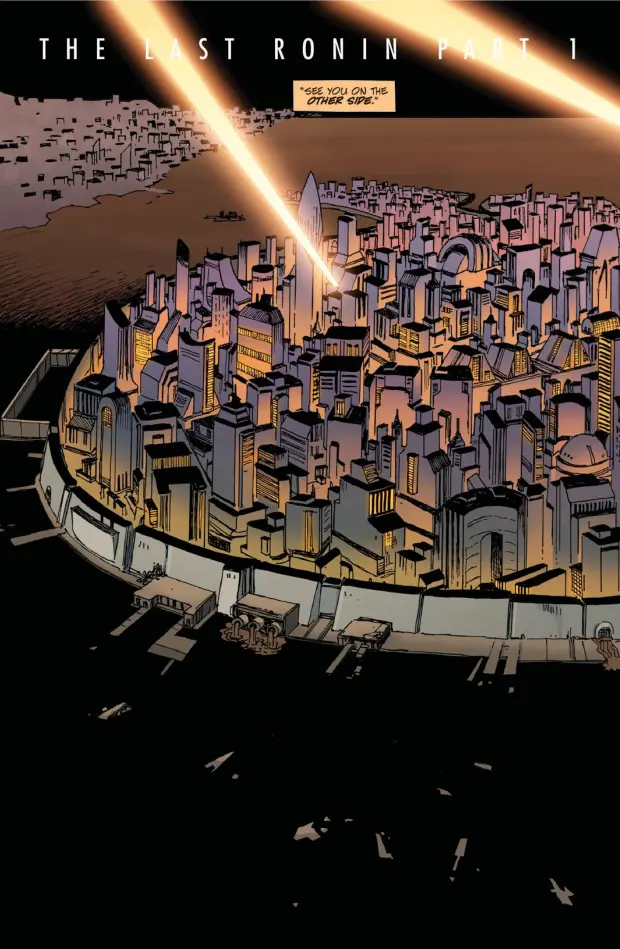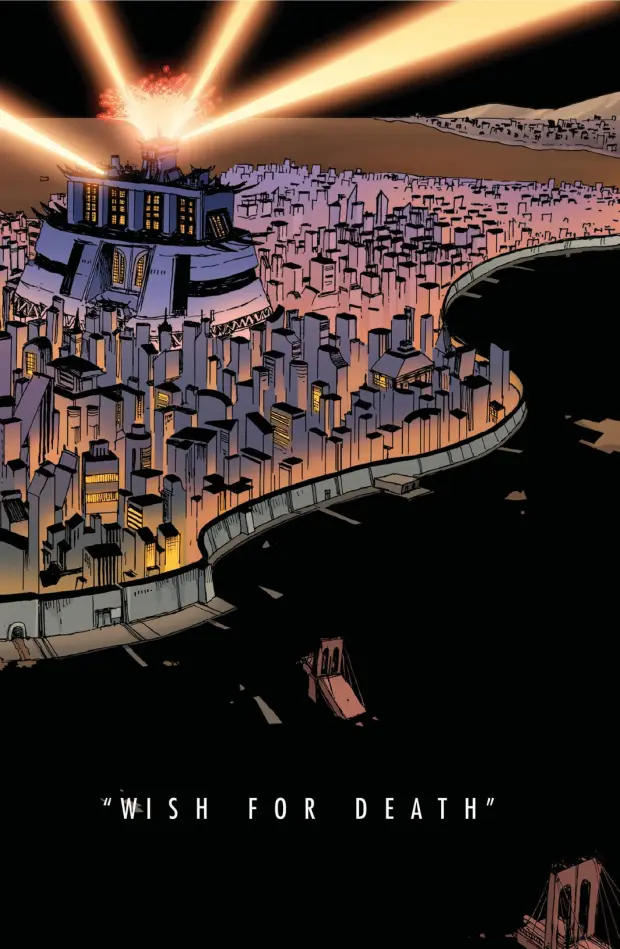TMNT: The Last Ronin is a 5-issue mini-series that was originally plotted by Eastman and Laird over 30 years ago and brought to life with the help of co-writer Tom Waltz. Along with a slew of talented artists including Esau and Isaac Escorza and Ben Bishop, colors by Luis Antonia Delgado, and lettering by Shawn Lee, this landmark mini-series was gifted with a murderers row of Turtles talent to craft a comic story that works as both a stirring tribute to stories past, and a fitting potential end to decades of TMNT comics.
In the year 2022, it is hard to capture the influence that the Teenage Mutant Ninja Turtles have had on comics and pop culture at large. From the now-classic 1990 film and its sequels, to numerous animated series, video games, and subsequent comics, the heroes in a half-shell are some of the most immediately recognizable fictional characters in all of media. Even those who have never seen any of the movies or read one of the comics could still likely name all four turtles and some of the extra cast. It’s surreal then that all of this started with a pair of friends drawing a black and white comic in a tiny living room in New Hampshire in 1984. Since then, Kevin Eastman and Peter Laird, along with dozens of collaborators, have continued the tales of the TMNT in hundreds of comic books over the span of 38 years. With that kind of legacy, and so much story that’s been told – how does it end? How can it end?
It should be made clear that The Last Ronin is not the *actual* end of TMNT comics at IDW. There will be, as far as anyone can know and hope, always be Turtles comic stories – as long as there are people waiting in the wings to tell them. The story that Eastman, Laird, and Waltz have crafted here is a sort of hypothetical “what if?” After years of war between the Hamato clan and the Foot clan, a decisive series of battles leaves only one member of the Turtles alive. After living in exile, he returns to New York to find the city under the authoritarian control of the Shredder’s grandson, and the newest rendition of the Foot Clan’s army. Now, while reconciling with the tragedy of his past and learning to trust his new allies, the last turtle – the last Ronin – fights to retake the city he and his brothers once defended. The comic splits at times into two narratives: the “present” story with the Ronin returning to New York, and the past, which shows readers exactly what happened to the brothers, Splinter, and their allies. Both plots are equally riveting, but watching the final moments of each of the brothers as they fought to the end is sure to leave many a Turtles reader’s heart feeling heavy.
As emotionally devastating as it is ass-kicking, the creators have written a story that encapsulates what the TMNT have been about as a cast and concept for their entire existence. While Splinter and his brothers are gone, the specters of the latter act as guiding voices for the remaining turtle – whose identity is actually a major twist, so I won’t divulge it here. Functioning as both reflections of his psyche and reminders of why he must carry on, the Ronin carries forward with his brutal mission with the help of allies new and old. Their identities are, once again, a spoiler, but I’ll just say that their reveal will be a welcome surprise for fans. The addition of the new cast members in and of itself is a reminder to readers of this mini-series that the TMNT – and what they mean as characters – will never go away, even if their stories ever eventually came to a proper end.
Even more impressive than the already top-tier writing is The Last Ronin‘s exploration of the Turtles’ history through art. Much like the script, the visual team’s work is both a modern treatment and a tribute to years past. Ben Bishop and the Escau’s both craft a style that utilizes modern approaches but still feels like an Eastman and Laird comic. The mix of contemporary polish and 80’s indie grunge captures the distinct aesthetic that Turtles comics have always had, but to a somehow even higher degree. The Last Ronin looks like it could be a super-impressive indie book, and that was likely the goal. This element of timelessness is especially noticeable when the story transitions to flashback pages drawn by Kevin Eastman himself. This is a noticeable visual change, but what remains so impressive is how the story doesn’t skip a beat. The modern artists trade pages with the original in an experience that feels like it’s coming full circle. The Ronin still has that signature design that’s sorta ugly, but also cool and strangely lovable that has been a staple since the original years. There are specific panels and sequences that will go down not just as some of the most memorable scenes in comics this year, but as some of the most impactful moments ever produced in a Turtles comic.
The final battles of the lost brothers are beautifully constructed and choreographed, and the homage panel for each character upon their death is equally striking and gut-wrenching. Watching the toll on the last brother in the “present” fight as he struggles physically and mentally with what has happened is equally devastating. The panels where the other brothers show up in the background of the first issue as they’re “talking” to their brother are a strange mix of haunting and reassuring. The art here wears the TMNT’s major influences on its sleeves too, with numerous homages to the legendary Frank Miller; a man who Kevin Eastman himself states was one of the primary reasons these comics exist. Luis Antonia Delgado’s colors paint the air of a polluted cyberpunk NYC at one moment and the snowcapped vistas of an ancient Japanese village the next all in a vibrant palette that perfectly matches the aims of the script and pencils. Shawn Lee’s lettering does much the same, with a distinct and easy to read font with cool, hand-drawn feeling SFX work that, like every other visual aspect here, blends classic and modern into a seamless reading experience.
TMNT: The Last Ronin is bookmark and a monument. This 5-issue mini-series is a a love-letter from the original creators, with the help of Tom Waltz, to both their creation and the fans that have supported these characters to the astronomical success they have achieved. A tale of tragedy, redemption, emotional renewal, and mutant turtle-powered ninjutsu, The Last Ronin is everything a reader would expect from a top-tier turtles comic – along with a lot of elements they would never see coming. A powerful script that is still wildly fun, visuals that perfectly ride the line between modern detail and old-school sensibilities, and some of the most memorable moments in comics in recent memory, all make for quite possibly the greatest single story in these characters’ long history. Now available in a gorgeous oversized hardcover, TMNT: The Last Ronin is a must read for fans of the heroes in a half-shell – no matter how you found them in the first place.

